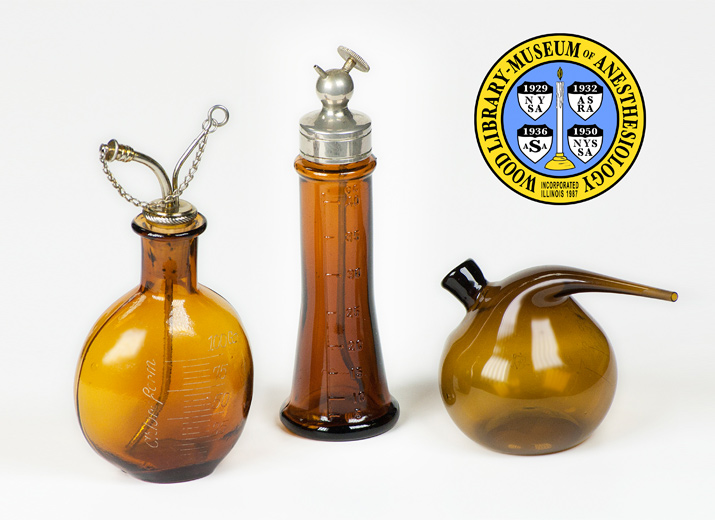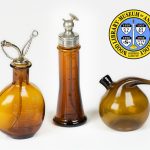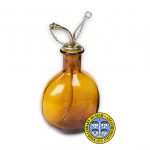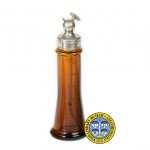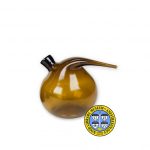Chloroform Drop Bottles
Pictured, from left to right, are a chloroform drop flask, a drop bottle with a control valve manufactured by Pilling & Son, and one of unusual, alembic form. Introduced just one year after ether, chloroform was the second drug to be used as a modern surgical anesthetic. In 1831, chloroform was ‘discovered’ almost simultaneously by Samuel Guthrie in the USA, Eugene Soubeiran in France and Justus von Liebig in Germany. In 1847, Dr. James Young Simpson, a Scottish obstetrician, began administering it to women for pain during childbirth. Chloroform quickly became a popular anesthetic for surgery and dental procedures as well.
A wide variety of bottles were used to store and administer chloroform. Chloroform was often administered by pouring it onto a cloth or sponge which was then held over the patient’s nose and mouth. To refresh the cloth, chloroform was applied drop by drop. Eventually wire masks and inhalers, which kept the soaked cloth away from the patient’s skin, were used to administer anesthetics.
These bottles are part of the Eric Webb Collection. Dr. Webb's generous gift was facilitated by Lucien Morris, M.D., Roderick Calverley, M.D. and the WLM Honorary Curator, George Bause, M.D. Also see the chloroform tin from a 'U.S. Army Surgeon’s Field Companion' kit.
Catalog Record: Chloroform Drop Bottles
Three Catalog Records (aijp, aijq, aijn):
Access Key: aijp
Accession No.: 1990-12-09-2 A 1
Title: [Chloroform drop bottle, flask form.]
Publisher: [S.l. : s.n., 1879-1929.]
Physical Description: 1 bottle : glass, metal, cork; 13.5 x 7.5 x 4 cm.
Subject: Chloroform.
Subject: Bottles.
Note Type: General
Notes: Title from the WLM name for the bottle.
Note Type: Physical Description
Notes: Chloroform bottle of amber colored glass with a round body and narrow neck;
The bottle-top is metal and cork, with two metal tubes protruding out through
the top; The longer outer tube is the chloroform spout and the shorter tube
allows air into the bottle; The tube for the chloroform spout extends into
the bottle; It is curved and almost reaches the bottom of the bottle; A pin
and cap at the end of a chain hang from the end of the air-vent tube, and can
be used to close off the chloroform spout; Etched into the glass, and filled
with white paint, are graduation lines and numbers; The lines indicate
increments of five, with longer lines and numbers indicating 25, 50, 75, and
100 “Gr”; The word “Chloroform” is etched vertically to the left of the
graduation marks.
Note Type: Reproduction
Notes: Photographed by Mr. William Lyle, 7/15/2010; Photographed with two other
chloroform bottles. The bottle described in this record is on the left.
Note Type: Historical
Notes: This bottle is part of the Eric Webb Collection. In 1990, Dr. George Bause,
the WLM Honorary Curator, traveled to Victoria, British Columbia, Canada, to
acquire items for the WLM museum, including the Eric Webb Collection. It may
include the largest collection of chloroform bottles assembled in North
America. The acquisition of these bottles was facilitated by Lucien Morris, M
D. and Roderick Calverley, M.D.
Access Key: aijq
Accession No.: 1990-12-09-2 A 3
Title: Pilling [chloroform drop bottle.]
Publisher: [Philadelphia, Pa.] : Pilling & Son, [1830-1950.]
Physical Description: 1 bottle : glass, nickel? ; 15 x 4.5 dia. cm
Subject: Chloroform.
Subject: Bottles.
Note Type: General
Notes: Title based on manufacturer markings on the base of the bottle.
Note Type: Physical Description
Notes: Chloroform bottle of amber colored glass, cylindrical in shape but gently
tapered so that the bottom of the bottle is slightly wider than the top; The
all metal (nickel?) cap is topped with a small spherical head from which
comes a short spout and a round, flat knob; The knob turns to open and close
a valve that controls the flow of chloroform; Raised graduation lines and
numbers mark the volume in increments of five from 5 to 40 “cc”; Marked in
the base is “Pilling & Son” with the P & S logo.
Note Type: Reproduction
Notes: Photographed by Mr. William Lyle, 7/15/2010.
Note Type: Historical
Notes: This bottle is part of the Eric Webb Collection. In 1990, Dr. George Bause,
the WLM Honorary Curator, traveled to Victoria, British Columbia, Canada, to
acquire items for the WLM museum, including the Eric Webb Collection. It may
include the largest collection of chloroform bottles assembled in North
America. The acquisition of these bottles was facilitated by Lucien Morris, M
D., and Roderick Calverley, M.D.
Access Key: aijn
Accession No.: 1990-12-09-2 A 2
Title: [ Chloroform drop bottle, alembic form.]
Publisher: [S.l. : s.n., 1830-1950.]
Physical Description: 1 bottle : glass; 7 x 6.5 x 10.5 cm.
Subject: Chloroform.
Subject: Bottles.
Note Type: General
Notes: Title from the WLM name for the bottle.
Note Type: Physical Description
Notes: Chloroform bottle of amber colored glass; The bottle is irregular in shape,
with an almost spherical body and a long, downward, tapered neck; Etched into
the glass, and filled with white paint, are 4 graduation lines and numbers;
The lines are numbered 1, 2, 3 and 4, with “oz” etched just to the right of
the number four; “Movol-Flask” or “Hoval-Flask” is etched below the
graduation lines.
Note Type: Reproduction
Notes: Photographed by Mr. William Lyle, 7/15/2010; Photographed with two other
chloroform bottles (aijp and aijq): The bottle described in this record is on
the right side of the image.
Note Type: Historical
Notes: This bottle is part of the Eric Webb Collection. In 1990, Dr. George Bause,
the WLM Honorary Curator traveled to Victoria, British Columbia, Canada, to
acquire items for the WLM museum, including the Eric Webb Collection. It may
include the largest collection of chloroform bottles assembled in North
America. The acquisition of these bottles was facilitated by Lucien Morris, M
D., and Roderick Calverley, M.D.
